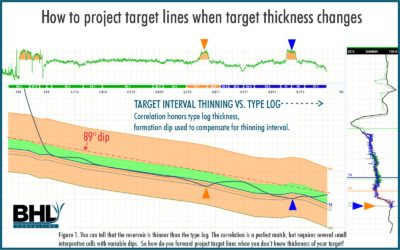A must-read for any geosteering geologist, geo-steering engineer and anyone involved or interested in horizontal wells and horizontal drilling!
Hopefully, you laughed out loud reading the 6 Stages of Geosteering (Un)Certainty and are well versed on importance of survey uncertainty after reading “Wellbore Positional Uncertainty in Horizontal Wells – Why You Should Care & How it Happens”. So, without further ado, I give you BHL’s top 10 sources of Wellbore Positional Uncertainty.
1. How Surveys are Taken
This is most impactful in the curve section. Common practice is to drill past a survey point (usually a pipe connection) by about 5-20’, then pull pipe back to the survey depth. If they don’t pull back to the same depth, there is an instant (and unseen) depth error. Above 60 degrees Inclination, over half of that error translates directly into TVD error.
2. Pipe Stretch and Thermal Expansion
We sometimes incorrectly assume that pipe length is the same at the surface and downhole. But drill pipe stretches with weight and temperature. This influence is small and progressive, but it’s always there.
3. Slide-Rotate Pattern in Curve
Angle is built in wellbores by a combination of sliding and rotating where small segments are drilled as alternating constant curve segments and straight segments. Wellbore geometry is typically calculated using minimum curvature, which assumes constant build rates. In worst case scenarios the TVD depths could be off by 25’ in either direction. If something seems weird it doesn’t hurt to ask for the slide report or even plot ROP data for a quick look.
4. Survey Measurement Uncertainty
Downhole survey tools measure two values of wellbore orientation: Inclination and Azimuth. This combined with MD (Measured Depth) from pipe tally are used to calculate all other wellbore position data. There is inherent uncertainty in the measurements made from the survey tools. Any inaccuracy in these measurements will manifest throughout the well and impact all the other calculated values.
5. BHA Sag
The BHA isn’t as stiff downhole as it looks at surface. The BHA can sag, depending upon placements of stabilizers, bent-sub motors, etc., leaving survey tool artificially tilted up or down by a few tenths of a degree. One study estimates that this might account for 80% of error in reported Inclination. And erroneous inclination values yield erroneous TVD values.
6. Survey Editing
Sometimes, unbeknownst to the end users, directional surveys edited after they are collected, sometimes even after the geosteering interpreter receives them. We have observed it in a couple instances firsthand. In one case, a directional driller altered survey data that had been collected during the night, because a few inclination values were higher than the operator would tolerate. It’s also not entirely rare that while-drill surveys are subtly different from those reported at TD.
7. Magnetism
Downhole compass units measure wellbore azimuth. This measurement can be pick up uncertainty by drift of the Earth’s magnetic field and accumulated magnetism in the BHA. There are even documented cases of “magnetic mud” due to metal shavings. Being mostly an Azimuth issue, this is a left-right problem, perhaps one to consider if fracs are seeing unexpected interference between laterals.
8. Pipe Tally
Recall that the only measured values of wellbore position are MD, Azimuth and Inclination. While azimuth and inclination are measured by downhole tools, MD is measured at the surface by pipe tally. Yes, automation is beginning to help here, but as much as we respect and value our rig crews, mistakes can happen. The magnitude can be quite large.
9. Survey Position Relative to Slide/Rotate Transitions
This effect has been documented by Stockhausen, Lowdon & Lesso (SPE/IADC 151248). A bent sub creates a hole larger than the size of the bit when rotating and only slightly larger than the bit when sliding. A “ledge” is imparted within the well bore at the transition between rotating and sliding. Survey data recorded at this transition measures inclination value that do not represent actual hole inclination.
10. Survey Spacing
Survey data are usually collected every joint of pipe (+/- 31’) in the curve, every stand of pipe (+/- 93’) in the lateral. We have taken wells that were surveyed every 31’ from kickoff to TD, then extracted only every third survey (93’ data) from landing. The impacts were huge, ranging up to 16.5’ apparent TVD difference and 2.4 degrees Inclination difference between the two data sets- from the same hole! Stay tuned for an upcoming blog with a more thorough review of this topic.
Now that you’re aware of the sources of well bore position uncertainty and potential error, we hope you are better equipped to make an informed geologic interpretation. Remember the importance of communicating with your team. If you have any doubts about surveys, just ask your drilling engineer or directional company. Remember, team work makes the dream work.
Do you have any other sources of well bore position uncertainty to share? Any examples of how these effects impacted your geologic interpretation? Comment below!






Great article and summary of the error potential. Geosteerers are mostly powerless to affect any changes that would tighten up the uncertainty. There is a whole other list of issues with GR readings and their uncertainty. This whole issue is the main reason why I’m more of a lumper than a splitter when steering. Many basins where shales are the target are relatively consistent dip. Trying to tie every GR character exactly often shows the errors as you mentioned than the true structural trend.